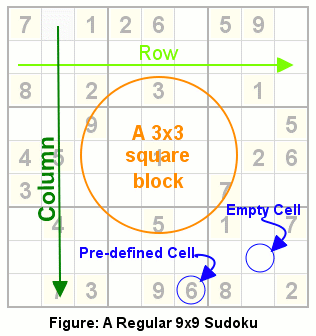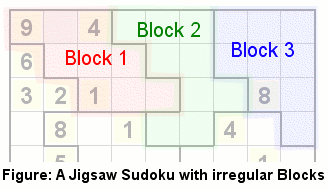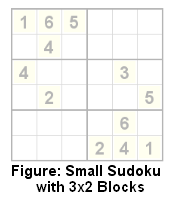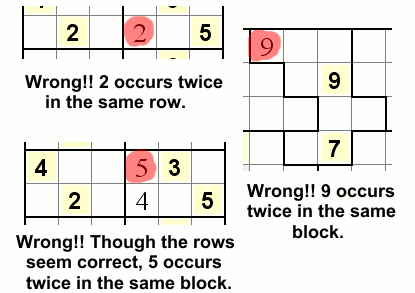Sudoku Tips and Algorithms
1.Terminology
2. Rules of Sudoku
3. Algorthims to solve Sudoku
Want to learn how to play Sudoku? Did a Sudoku variation leave you puzzled? Fear not. You have come to the right place. Here we will explain the rules of Sudoku, and in no time you will be on your way to becoming a sudoku solver yourself!!
1. Terminology
Before we go further, let's establish some terminologies which we will be using in later sections.Cell: A cell is a square box in a sudoku game in which a number/letter can be entered. A cell can be either pre-defined or empty. Pre-defined cells are fixed in a sudoku and their values cannot be changed. Empty cells are empty to begin with, and the user/player must fill in the correct value.
Block: A block (or a cell-block) is a group of cells in a Sudoku game. A block can be distinguished from normal cells by its thicker border. A block can be a regular block of NxN cells in the form of a square, or can be of an irregular shape. Both kinds are blocks nonetheless.
Row: A row is a horizontal collection of cells in a Sudoku game.
Column: A column is a vertical collection of cells.
The following figures show the above concepts on a Sudoku game grid:



2. Rules of Sudoku
Now, the easier part:- An N celled block (for example, a 3x3 block will have 9 cells) should be filled with numbers from 1 through N. This way, a 3x3 block will be filled with numbers 1 through 9.
- No two cells within one block can have the same number.
- No two cells in a row can have the same number.
- No two cells in a column can have the same number.
To make the above rules clearer, following figures illustrate some wrong entries:

That's it!! You're now officially qualified to solve Sudoku games.
3. Different Levels of Algorithm
- Reducing Block Possibilities
- Finding Unique Possibilities
- Block Overlap Reduction
- Repeated Possibility Reduction
- Combined Possibility Reduction
- Apply Possibility Reduction
4. Consecutive Sudoku Algorithms
- Apply Consecutive Constraint
- Consecutive Chain Min-Max Reduction
- Consecutive Chain Neighbor Reduction
5. Greater Sudoku Algorithms



